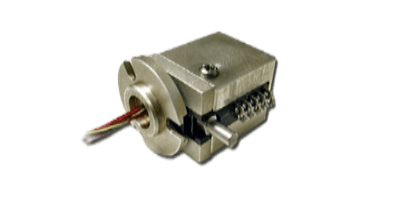What Is a Slip Ring?

A slip ring is a rotating connector that can transmit power or electrical signals from outside the rotating body.
Power and signals are transmitted through a metal ring placed on the rotating body and a brush on the fixed side. It is used to measure the vibration, stress, and axial force of the rotating body and to transmit minute signals for control purposes. They are often used to serve as lead wires that supply power to the rotating body.
There are two main types of slip rings: shaft-end mounted and hollow. The shaft-end type is attached to the end of the rotating element. The hollow type is a ring block that is fitted into the rotating shaft. There are also two types: one in which the ring and brush are integrated, and one in which the ring and brush are separated.
Uses of Slip Rings
Slip rings are available from low-speed rotary applications to 20,000 rpm high-speed applications. Some slip rings can handle high currents of 3,000 A or more, and are widely used in applications ranging from experiments and development to equipment.
They are used to supply power to wind power generators, machine tools, centrifuges, agitators, robot arms, cranes, surveillance cameras, helicopters, turntables, drum heaters, radar antennas, and other rotating body heaters and motors.
They also have a wide range of applications in semiconductor manufacturing equipment, medical equipment such as CT scans, non-destructive testing, and acoustic equipment. They are also used to measure the temperature, strain, and torque of rotating bodies.
Principle of Slip Rings
A ring-shaped electrode part (ring unit) is attached to a rotating shaft, such as a turntable of a rotating body. Brush-shaped electrode parts contact the periphery and sides of the ring unit, and power and signals are transmitted using the points of contact as contact points.
Even if the ring unit rotates, it always has a contact point with the brush, thus enabling stable power supply and signal transmission. The ring unit has bearings to support the brush side.
Precious metals such as copper and silver are used for the contact points between the ring and the brush in the slip ring to stabilize the contact resistance without any risk of leakage. Bronze, silver, and gold are used for the ring, while carbon, copper, and silver alloys are used for the brush portion.
Slip rings are inevitably larger when there are many wires for power or signals. They also wear to a certain degree, so regular maintenance is required.
Other Information on Slip Rings
1. The Role of the Brushes in a Slip Ring
Slip rings transmit and receive from the electrical equipment on the rotating body to the stationary side, with the brushes acting as contacts. Since the brushes are always in contact with the rotating body, the transmission and reception can take place anywhere in a 360° position without wiring kinks or tangles in the shaft.
The number of brushes (contacts) varies according to the number of signals that need to be transmitted and received between the rotating body and the fixed side. Therefore, the more communication devices there are, the more brushes are required, resulting in the overall slip ring becoming huge.
In this case, the number of brushes can be reduced by using serial communication or CAN communication used in automobiles.
2. Disadvantages of Slip Rings
The disadvantage of slip rings is the possibility of contact failure due to brush wear. Since the brushes are in physical contact with the rotating parts, contact failure may occur due to deterioration over time.
Especially in equipment used outdoors, brushes may be damaged prematurely by sand, dust, or water intrusion if they are not protected by a sealed case. Therefore, it is common practice to extend the life of brushes by cleaning and lubricating them once every few years.
The lubricant used at this time should be conductive. Note that if it is not conductive, there is a risk of poor current flow in the brush section, resulting in poor communication between the rotor side and the fixed side.
The life of the brush section is generally from 10 million to 100 million rpm, and up to about 500 million rpm, depending on the manufacturer. When used in long-life equipment, the brush section needs to be maintained periodically.